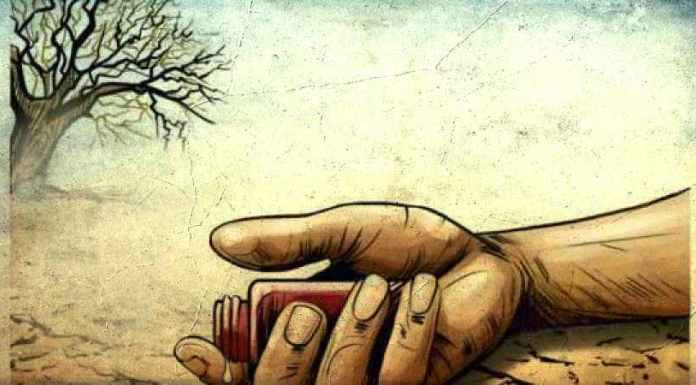This was first published in the print edition of Manushi journal, Issue no. 157 of 2006.
Chandrakala Meshram of village Sai Kheda in District Yavatmal of Maharashtra has spent most of her 33 or so years of life as a farm labourer, contented to collect her Like many farm women she too does not know how old she is exactly. Chandrakala said her age ‘must be 30…maybe a little more’. She belongs to the Gond community. Never, even in her wildest dreams, had she imagined that one day she would find herself in the employer’s shoes. For the last nearly two months she is trying to grasp the idea that she is now a farmer.
On October 2, 2006, her husband Gangaram hung himself from a beam on the roof of their house. “Of course I will have to farm my land,” she replies coolly, “How will I manage, otherwise, with two daughters?” And what does she know about farming? Not much. “I will have to ask someone to help me with getting loans and buying seeds,” she mumbles, “The seeds these days are strange. I don’t know what type they are, but they take up too many favarnis (pesticide sprays). I will have to get a gadi (farm manager) to run the farm, don’t you think, didi?” Her family owns five acres of land which is registered in her father-in-law’s name.
Why did her husband commit suicide? Chandrakala’s cheerful face clouds at once. “I don’t understand,” she replies vacantly, “We had no fights. My husband was cheerful and gammati (funloving). He was always giving these nakkal (local performing art) performances in the village. He killed and stuffed that belmanjar (wild cat) just for that,” she says, pointing to the object hanging in the verandah.
It is only after a few minutes of brooding that she becomes more coherent, “For three years the crops were bad. We have no water source. If it rains there is a crop, if it doesn’t, there is none. For the last few years there was drought. We even had to sell our bullocks.”
But this year, the rain god had at first appeared to bring hope. “The soybean crop was coming up good,” says she, “But then it rained so hard that it all got washed away. We had to do two resowings. Even then the crop did not come up good.”
The soybean crop was standing ready for harvest on the day he committed suicide. Talking of that day, Chandrakala looks lost. “It was evening, almost bed-time. Dussehra day it was, and the children were out late. I went out to call them home, and when I came back I found him hanging from the beam of the roof. I don’t understand. I don’t understand at all.”
As Chandrakala lapses into brooding silence, Gangaram’s younger brother Parasram speaks up, “We harvested the soybean crop after he died. The crop was very bad. Hardly anything.”
“He knew the crop was bad,” murmurs Chandrakala, “But he never told me.” As we talk further, Chandrakala appears to be thinking aloud rather than talking, “He had stopped telling me anything. Where money was coming from, who he was borrowing from, what the crop was like. He was not like that earlier.”
Does she know how much the family owed in loans? “We had borrowed Rs 15,000 from the bank,” she said, “The rest I don’t know. He was bringing money home, but he would not tell from where.” “He used to look tired more often. He was brooding. I had never seen him that way before,” Gangaram’s aunt Parbata Bai says.
Was there food in the house on that fateful day? “No,” replies Chandrakala, “There was nothing. There had been no grain in the house for months. We used to buy a little every two-three days and manage somehow.
The conversation is getting too heavy, so I turn it to the future. Chandrakala’s two daughters, aged 12 and 9, are in school. Since the elder daughter is in an ashramshala – free residential school for tribal children – there are going to be just two mouths to feed, though even that is going to be far from easy. But managing the farm?
That is a different question altogether. “The cost of seeds and fertilizers have gone up steeply in the last three-four years,” says Parasram, whose own finances are in the doldrums, “We have lost our seeds.”
“Yes, only seeds cost thousands of rupees now,” chips in Chandrakala, “Resowing is such a nightmare. And the fertilizers and sprays (pesticides) – oh, they are killers!”
And what about managing the farm work? “I will just have to get a gadi. How can a lone woman manage a farm without a man?” she says. She has no idea, though, about how she is going to pay the gadi or find money for the seeds for the second crop. “I don’t know,” she replies with the characteristic stoicism of the farming community, “I will pay him after the crop maybe. Someone will give me seeds, I will pay them back after the crop. People do help. We will see…… something will turn up……”
And what about the loans that her husband has left behind? For the first time, Chandrakala’s head sinks onto her knees. Pressing her forehead with her hands she replies in a very low voice, “I don’t know. I can’t think any more.”
It is time to go. I snap photographs. First Chandrakala, then Chandrakala with her daughters, and finally the stuffed wild cat. And oh god! Everyone is laughing. Honest, wholesome laughter of genuine amusement at a stupid urban female’s interest in common knick-knacks.
Before I leave, I turn to look once more at Chandrakala’s laughing face.
The author is a freelance writer based in Nagpur

